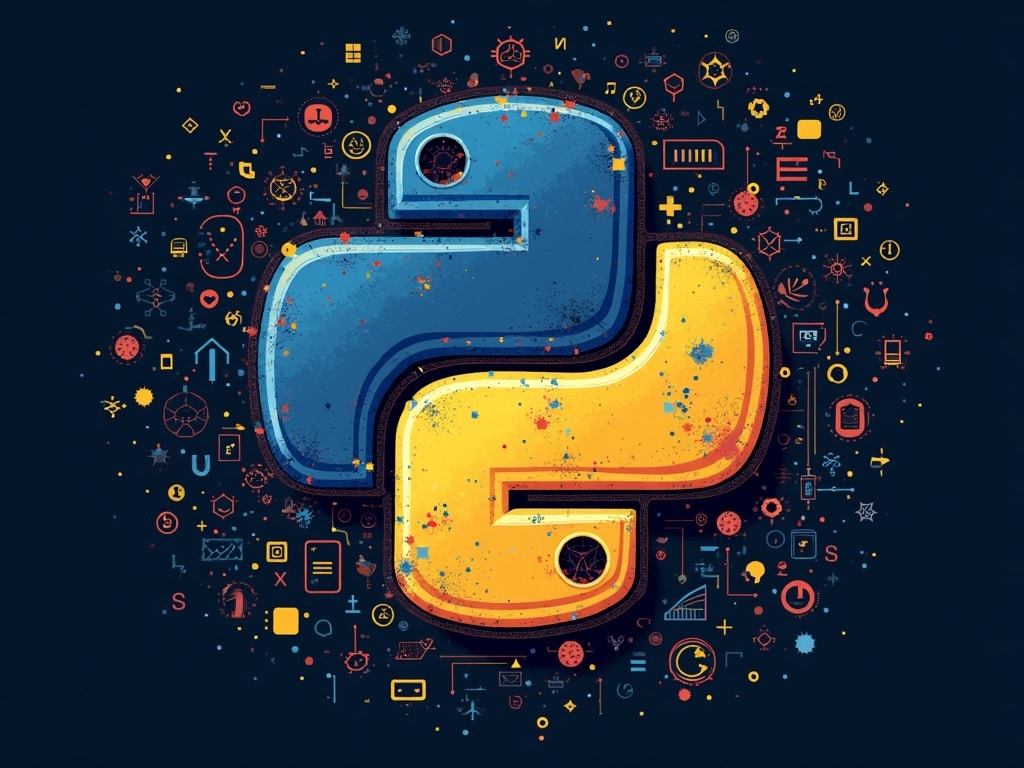Python for Non-Programmers: A Gentle Introduction
Imagine automating those tedious spreadsheet tasks that eat up your afternoons, or building a simple website to showcase your pottery. Maybe you just want to understand what all the hype around coding is about. If you’ve ever felt a spark of curiosity about the world of programming but thought it was beyond your reach, think again. Python, a versatile and beginner-friendly language, is ready to welcome you.
Why Python is Perfect for Beginners
Forget the intimidating images of complex code filled with cryptic symbols. Python is designed to be readable, almost like plain English. This focus on clarity makes it an excellent starting point for anyone new to programming. But don’t let its simplicity fool you. Python is also incredibly powerful, used by everyone from Google and Netflix to NASA. That’s the magic of Python: easy to learn, but capable of achieving amazing things.
Readability Counts
One of Python’s key principles is readability. Code should be clear and easy to understand, even for those who didn’t write it. This is achieved through a clean syntax that emphasizes indentation rather than braces or keywords, making the code visually uncluttered and easier to follow. If you can read English, you can likely grasp the basic logic of Python code.
A Vast and Supportive Community
Learning to code can feel daunting, but you’re not alone. Python boasts one of the largest and most active communities in the programming world. This means a wealth of online resources, tutorials, forums, and libraries are readily available to help you every step of the way. If you get stuck, chances are someone has already encountered a similar problem and shared their solution online. It also means that meetups, workshops, and conferences devoted to all different levels of Python are not difficult to find.
Versatility is Key
Unlike some languages tied to specific platforms or purposes, Python is remarkably versatile. From web development and data science to machine learning and scripting, Python can handle it all. This means that the skills you learn with Python can be applied to a wide range of fields and projects. Whether you want to build a website, analyze data, or automate tasks, Python is a valuable tool to have in your arsenal.
Getting Started: Setting Up Your Python Environment
Before you can start writing Python code, you need to set up your development environment. Don’t worry; it’s not as complicated as it sounds:
Installing Python
First, you’ll need to download and install Python on your computer. Visit the official Python website (python.org) and download the latest version for your operating system (Windows, macOS, or Linux). The website provides clear instructions for installation. During the installation process, make sure to select the option to add Python to your system’s PATH environment variable. This will allow you to run Python from the command line.
Choosing a Text Editor or IDE
Next, you’ll need a text editor or Integrated Development Environment (IDE) to write your Python code. A text editor is a simple program for creating and editing plain text files, while an IDE provides a more comprehensive set of features for software development, such as syntax highlighting, code completion, and debugging tools.
Some popular text editors and IDEs for Python include:
- VS Code: A free and versatile code editor with excellent Python support.
- Sublime Text: A popular text editor known for its speed and customizability (paid license required after a trial period).
- PyCharm: A powerful IDE specifically designed for Python development (both free Community and paid Professional versions available).
- Thonny: A beginner-friendly IDE that comes pre-installed with Python and includes helpful features for learning.
For beginners, Thonny is often the best starting point due to its simplicity and ease of use. As you become more comfortable with Python, you can explore other text editors and IDEs to find one that suits your needs.
Your First Python Program: Hello, World!
Once you have Python and a text editor/IDE installed, you’re ready to write your first program. Open your text editor or IDE and create a new file named `hello.py`. Then, type the following code into the file:
python
print(Hello, World!)
Save the file and then open a terminal or command prompt. Navigate to the directory where you saved the file and run the program by typing `python hello.py` and pressing Enter. You should see the message Hello, World! printed on the screen. Congratulations, you’ve just run your first Python program!
Basic Python Concepts
Now that you’ve got your environment set up and written your first program, let’s dive into some basic Python concepts.
Variables: Storing Information
Variables are like containers that hold information. You can assign values to variables and then use those variables in your code. For example:
python
name = Alice
age = 30
print(Hello, + name + ! You are + str(age) + years old.)
In this example, we’ve created two variables: `name` and `age`. The `name` variable holds the string value Alice, and the `age` variable holds the integer value 30. We then use these variables in the `print()` function to display a message.
Data Types: Understanding Different Kinds of Information
Python has several built-in data types, each representing a different kind of information. Some of the most common data types include:
- Integers (int): Whole numbers, such as 1, 10, -5, and 0.
- Floating-point numbers (float): Numbers with decimal points, such as 3.14, 2.5, and -0.01.
- Strings (str): Sequences of characters, such as Hello, Python, and 123.
- Booleans (bool): Represents truth values, either `True` or `False`.
Understanding data types is important because it allows you to perform different operations on different kinds of information. For example, you can add two integers together, but you can’t add a string and an integer directly.
Operators: Performing Calculations and Comparisons
Operators are symbols that perform operations on values and variables. Some common operators include:
- Arithmetic operators: +, -, *, /, // (floor division), % (modulo), (exponentiation)
- Comparison operators: == (equal to), != (not equal to), > (greater than), < (less than), >= (greater than or equal to), <= (less than or equal to)
- Logical operators: `and`, `or`, `not`
For example, you can use the `+` operator to add two numbers together, the `==` operator to compare two values for equality, and the `and` operator to combine two boolean expressions.
Control Flow: Making Decisions
Control flow statements allow you to control the order in which code is executed. The most common control flow statements are:
- `if` statements: Execute a block of code only if a condition is true.
- `else` statements: Execute a block of code if the condition in the `if` statement is false.
- `elif` statements: Chain multiple `if` statements together.
- `for` loops: Iterate over a sequence of values.
- `while` loops: Repeat a block of code as long as a condition is true.
For example, you can use an `if` statement to check if a number is positive or negative, a `for` loop to iterate over a list of items, and a `while` loop to repeat a block of code until a certain condition is met.
Practical Applications: Putting Python to Work
Now that you have a basic understanding of Python concepts, let’s explore some practical applications.
Automating Tasks
Python is excellent for automating repetitive tasks, such as:
**File management:Renaming, moving, copying, and deleting files.
**Data processing:Cleaning, transforming, and analyzing data from spreadsheets or text files.
**Web scraping:Extracting data from websites.
For example, you could write a Python script to automatically rename all the files in a folder according to a specific pattern, or to extract all the email addresses from a web page.
Data Analysis and Visualization
Python is a popular choice for data analysis and visualization due to its powerful libraries such as NumPy, pandas, and Matplotlib. These libraries provide tools for:
**Data manipulation:Filtering, sorting, and aggregating data.
**Statistical analysis:Calculating descriptive statistics, performing hypothesis testing, and building statistical models.
**Data visualization:Creating charts, graphs, and plots to explore and communicate data insights.
For example, you could use Python to analyze sales data, visualize customer behavior, or predict future trends.
Web Development
Python can also be used for web development, thanks to frameworks like Django and Flask. These frameworks provide tools for:
**Building web applications:Handling user requests, managing data, and rendering web pages.
**Creating APIs:Exposing data and functionality to other applications.
**Developing dynamic websites:Creating interactive and engaging user experiences.
For example, you could use Python to build a blog, an e-commerce site, or a social networking platform.
Resources for Continued Learning
Your Python journey has just begun, and there are countless resources available to help you continue learning. Here are a few suggestions:
**Online Courses:Platforms like Coursera, edX, and Udemy offer a wide variety of Python courses for all levels.
**Interactive Tutorials:Websites like Codecademy and DataCamp provide interactive tutorials that allow you to learn by doing.
**Official Documentation:The official Python documentation is a comprehensive resource that covers all aspects of the language.
**Books:There are many excellent books on Python programming, ranging from beginner-friendly introductions to more advanced topics.
**Online Communities:Join online forums, mailing lists, and social media groups to connect with other Python learners and experts.
Embrace the Journey
Learning to code is a journey, not a destination. There will be challenges along the way, but don’t be discouraged. Embrace the process of learning, experiment with different ideas, and don’t be afraid to ask for help. With dedication and perseverance, you’ll be amazed at what you can achieve with Python. Who knows? Maybe you’ll be the one building the next big thing. So go forth, code, and create!

